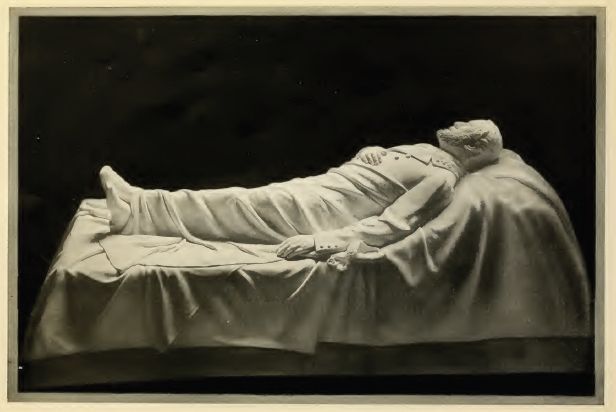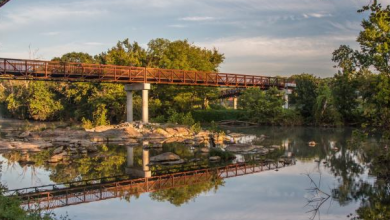Will Washington & Lee University Wall Off Historic Site?

Virginia, known as “The Cradle of Presidents,” has held an important and honored place in American history. For example, due to British explorers founding Jamestown along the James River in 1607, the Old Dominion became the birthplace of English-speaking America. Signage from the National Park Service explains that, owing to Richmond serving as the capital of the Confederacy from 1861-1865, the Richmond area has by far more Civil War-related sites than any other region in the country.
Even after the guns fell silent across Virginia following General Robert E. Lee’s surrender to General Ulysses S. Grant at Appomattox on Palm Sunday in 1865, countless aftershocks and fallout from that war have influenced and haunted the nation.
Whereas in most countries in world history, when the leader of a rebellion is defeated and captured, the winning side executes him. In an amazing example of grace and forbearance, however, the victorious Union did not kill Confederate General Lee. In contrast, they let him go free into a peaceful retirement where he could chose his own path for the remaining five years of his life.
Seeking for a way to serve his newly-reunited nation in 1865 and realizing the tremendous power of education to lift both individuals and a culture, Lee took up the challenge to serve as president of a small, struggling college in Lexington, Virginia when the board of trustees invited him to serve as college president.
That school, which opened in 1749, was first known as Augusta Academy. Although it has changed its name several times, it is one of the oldest continually-operating schools in the nation. In 1776 it was renamed Liberty Hall Academy, owing to the patriotic fervor in the land. The school was struggling financially in 1796 when George Washington gave them 100 shares of stock in the James River Canal Company to keep them solvent. That stock had been a gift from the General Assembly of Virginia to thank Washington for his remarkable service to the Commonwealth. To recognize his gift, the school was renamed Washington Academy and then in 1813 rechristened as Washington College.
Many today are unaware of the personal connections between Lee and Washington. Lee’s father, “Light-horse Harry” Lee, was a renowned general of the Revolutionary War and trusted aide to General Washington. The younger Lee married the daughter of Washington’s adopted son.
Washington College was one of the few colleges in the South to remain open during the entire Civil War. Fewer than 50 students were enrolled in 1865. As a younger man, Lee has earlier been superintendent of the US Military Academy at West Point, where he earned the reputation as a creative educator and planner. Moreover, even though he had fought for the defeated Confederacy, Lee was highly regarded in the North as well as the South as a man of honor, so the trustees thought that having a president of his stature could attract students from across the nation and thus help keep the institution afloat.
Lee took up the task, boosted the school’s enrollment and faculty, and helped it establish a reputation and path that has taken the school to survive from the days of Reconstruction to being the highly-acclaimed liberal arts college it is today. By the time Lee died in 1870, the school was again on firm financial footing and enrollment had grown to 400. To honor the Virginian who endured defeat and came out of retirement to help save the school, the faculty suggested and the trustees agreed to give it the name it has today: Washington and Lee University (W&L).
Remarkably, 152 years after his death in 1870, Lee and his name are again making headlines, this time regarding a controversial plan to wall off his tomb from the campus chapel.
The Roanoke Star reached out to the information office of Washington and Lee for the administration’s comments and perspective on this issue. After an initial contact was made, no further information from the university or its president, William Dudley, has been received. Moreover, since the Lee Tomb has been designated as a National Historic Site and such places are required by law for protection from defacement or significant renovations, The Roanoke Star also reached out to the offices of Gov. Glenn Youngkin (R) and Congressman Ben Cline (R), who represents the 6th District that stretches along the I-81 corridor from Roanoke to Winchester, and thus includes Lexington. However, no responses have been received from those offices either.
The Roanoke Star was, however, able to conduct an interview with Tom Rideout, a 1963 graduate of Washington and Lee, who expressed eagerness to get the word out and educate people about what is happening at his alma mater. Rideout, along with some other alumni and concerned individuals, formed “The Generals Redoubt.” According to their website, the group’s mission statement is to, “empower alumni, students, and parents in the Washington and Lee University community to advance Washington and Lee University’s unique history and traditions of honor, civility, and classical liberal arts education.”
Rideout calls The Generals Redoubt “an alternative alumni association, because the school’s alumni association has been “blank check” supportive of everything that the trustees and administration has decided to do.”
Since Rideout is the only person to respond to the requests for information for this article, all quotations are his.
Rideout begins his timeline with the 2017 violent riots in Charlottesville regarding Civil War statues. That tragic event impacted the new president at W&L, William Dudley, who had started his new position on January 1 of that year, after a stint as provost at Williams College in Massachusetts. Dudley was very upset about what had happened in his city of birth, Charlottesville, and he announced he would create a commission on “institutional history and community” to run during late 2017. It later produced a report with 31 recommendations for the administration and board of trustees to follow. The general tone of it is what today is known as “cancel culture.”
Rideout claimed: “Basically the conclusion was, that the history of the period when Robert E. Lee was president, the Civil War period, was a black mark on America and that it needed to be deemphasized. In other words, the tone was, we need less of this, not the same amount or more.”
After the commission made its findings public, it triggered a backlash among some alumni. Two in particular, from the classes of 1964 and 1966, co-authored a letter explaining their opposition to the findings and how they are inconsistent with the history and culture of W&L. Over time, between 750 to almost 1,000 alumni signed the letter to show they shared those concerns and opposed the new “cancel culture” the administration was embracing.
“We were told at that time by the then-rector of the university that more than likely nothing much would come of the report, and while that gave us some comfort, that October, in fact, a number of actions were taken by the board of trustees,” Rideout added.
Among those actions, the trustees soon rolled out a number of changes, primary among them, renaming some buildings. One building on campus was the Lee-Jackson House, given that title because the dwelling had belonged to both men at different times. University administration renamed it the Pamela Simpson House, a leader in the W&L co-educational movement. Rideout cited that “she was actually my daughter’s main faculty adviser/teacher, a wonderful woman,” but there were a number of other buildings that were renamed as well.”
In addition to the renaming campaign, another issue that raised the ire of many among the alumni and community involved a famous statue of the general. “The most egregious to us, at the time, was a rule which basically said, that whenever the Washington and Lee community gathered in the Lee Chapel, that the recumbent statue (…) of Lee lying in battle dress (…) would no longer be viewable by students because it might distract them from whatever the program was that was going on…. It’s a magnificent artwork and it’s been there ever since [1883] and it’s been accessible to view it and also physically accessible from the auditorium of the school.”
“In other words, [the university administration] wanted to protect the students as Washington and Lee University from one of the namesakes of the university, and all that’s very curious to us. We wondered at the time and we still wonder why they would bring people to the school who would have a problem with going to a school that was named for Robert E. Lee or George Washington, for that matter.”
The same question could be asked of W&L President Dudley. A native of Charlottesville and clearly a highly-educated man, Dudley must be personally aware of the history, culture, and legacy of western Virginia. If the name and legacy of Robert E. Lee are offensive to him, or if W&L suffers from “systemic racism” as some allege its neighbor school VMI to suffer from, why would he risk sullying his career and resume by leaving an academic post in New England and taking the head position at a college that is not only named after Lee but also the site of his grave?
Since no response for more information from W&L has been received, that question among many others remains unanswered.
The famed marble statute that is now the center of the firestorm of controversy was created by Edward Valentine and dedicated in 1883. Lee’s actual tomb is in the lower level of the chapel, along with the graves of some other family members.
Fast forward to June 2021. The board of trustees conducted a six-month discussion whether to keep the Washington and Lee name or else change it. On June 4th, that committee announced they would retain the name. News that the name would remain unchanged caused some disgruntled faculty members to claim they might seek employment elsewhere. What is unknown, however, is why those faculty found keeping Lee in the name to be off-putting if they took a position on that campus in the first place?
However, in contrast to retaining the school’s name, they also announced some other steps “that would begin to erase the legacy of both Washington and Lee.” Rideout cited three major changes on campus:
First, since the 1870s, the diplomas for the undergraduate and law school students “are adorned with classic images of both Washington and Lee,” but a few years ago some law school students made the request that they have the option to receive a diploma either with or without those images.
However, starting with the recently-graduated Class of 2022, all diplomas would be the same, “image-free” documents. “So there’s a pretty good sign of trying to erase history or erase legacy,” Rideout commented. Therefore, the 2022 graduates were the first W&L grads since the 1870’s to receive their diploma without those likenesses. “So that’s a pretty significant thing.”
Second, another tradition that has been axed went back to the time of Lee’s passing in October 1870. At that time, the trustees declared that there would be in effect a “holiday and a day of remembrance, not only for Lee, but also for George Washington,” and that tradition has continued. However, the last one was held in Lee Chapel in 2019, but in “2020 and 2021 they melded that particular holiday into some other things that had to do with the beginning of winter quarter, and it in effect was downplayed for a couple of years, and it was eliminated this year, in January of 2022. There was no celebration of Founders’ Day at all. So, if you’re talking about erasing history and you’re talking about a day dedicated to the founders, it indicates you’re pretty serious about erasing their particular legacy.”
Third, and what Rideout labels “the bombshell,” was the news that Lee Chapel would have its name changed, effective June 4, 2021, to “University Chapel.”
It was during Lee’s tenure that Lee, a man of deep faith, wanted to have a chapel erected on campus. He oversaw the fundraising efforts and it was completed during the third year of his presidency. When dedicated, it was called “College Chapel.” It was not until after he died it was renamed “Lee Chapel,” and in 1918, “Lee Memorial Chapel.”
“So it’s been known to all the alumni, to us living, as ‘Lee Chapel.’”
In addition to changing the chapel’s name, all the plaques, portraits, and other historical memorabilia have been removed and put in storage. Raising considerable ire, many of the plaques and such honor military service of alumni, not only in the Civil War, but also World War I and World War II. “So these are men and their families who have been honored for decades and decades and decades, and now all of that has been taken down and put away. It doesn’t mean it will be put away forever, but all that has been disrupted.”
As a part of the school’s rebranding, there is a plan to build an “institutional history museum,” and those items will reportedly be housed in that new facility when it is built.
In other words, since the 1870’s, the chapel has doubled as a kind of history museum and almost shrine, but all those historical artifacts have been stripped away. Rideout claims some 40,000 folks visit Lee Chapel per year, owing to its significance as an historic site. With the artifacts all gone now, however, “there’s nothing really to see, other than (…) the recumbent statue.”
An attraction that draws about 40,000 visitors a year also brings in considerable financial benefits to the Lexington community and I-81 corridor, including hotels, restaurants, gas stations, etc. Virginia has long been a mecca for Civil War history enthusiasts, and Lee’s Tomb is an important site for history and fine art aficionados.
Most offensive to members of The Generals Redoubt community and those opposing the changes at W&L, however, is the administration’s plan to “wall off” or erect some kind of barrier or screen to block off the statue area from the rest of the chapel. In other words, after such a wall is erected, no one in the main chapel sanctuary area will be able to see or access the statue.
Instead, visitors curious to see the statue will need to exit the sanctuary, walk down the hill, and enter the lower level of the chapel. That area also serves as a kind of museum and displays the Lee’s office while he was college president. From that lower area, one can climb a flight of stairs to visit the statue area.
In June 2022, signs suddenly appeared announcing that the chapel would be closed for the summer, “and we could only assume that it was going to be closed so that this wall could be constructed, but apparently something has happened to indicate that, if nothing else, the wall isn’t going to be built right now, so they’ve reopened the chapel, I think three days a week.”
Rideout is not sure, but he suspects fire escape protocols may have thrown a monkey wrench into the plans to wall off the statue. He pointed out, when the chapel is seating some 500 people, in the event of an emergency, the attendees could exit from the back door or else go down the stairs at the front, by the statue. If the front is walled off, however, no such exit would exist.
So, for the moment it would seem, the need to escape a fire is blocking some peoples need to escape history.
A key aspect of this conundrum is the fact that the nondenominational Lee Chapel was declared a National Historic Landmark in 1961. To those who see it as a shrine to racism or “the Lost Cause” or a celebration of the Confederacy, it should be pointed out that the president in 1961 was John F. Kennedy, a liberal Democrat from Massachusetts. Places win the honor of being a National Historic Landmark upon designation from the National Park Service, which is under the Department of the Interior, which is in the executive branch and thus under the president’s purview.
Moreover, National Historic Landmarks enjoy certain protections. In the case of Lee Chapel, yes, the building belongs to Washington and Lee so, on on one level, the university administration is free to use or modify it as they wish. On the other hand, however, school leaders must respect its designation as a site of national historic significance lest they run the risk of running afoul of the law.
To place this in context, some homes and sections in Old Southwest in Roanoke City have been identified as historic properties. Yes, the deed holder owns the home. However, those owners must respect certain parameters and guidelines when remodeling their homes, especially on the outside, and would need to check carefully before, say, installing solar panels, a huge TV dish, or a “BLM” or “MAGA” mural on the wall.
Rideout notes that The Generals Redoubt has sought to be helpful and proactive by suggesting to the college and the city that a new building be erected on the western side of campus. (As a reminder that one cannot truly escape history, the site of that proposed building would be on Lexington’s Lee Avenue.) Such a structure could offer a large auditorium, art gallery and other exhibit space, and a place to tell more of the university’s illustrious past. In turn, the school could then rent out the enlarged space to other groups seeking to host events.
By creating that new structure, the chapel could be returned to its original structure and purpose.
President Reagan made global headlines with his 1987 plea in West Berlin to the USSR dictator, “Mr. Gorbachev, tear down this wall.” In contrast, The Generals Redoubt and many others in the Lexington community can be summed up as, “President Dudley, don’t build that wall.”
“We will see where all of that goes,” Rideout concluded.




